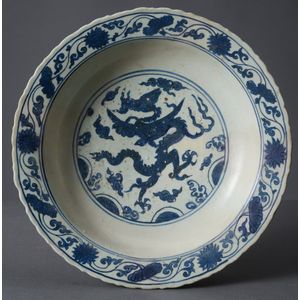Ming Dynasty Yinglong Dragon Charger
A Chinese blue and white Yinglong dragon charger Ming Dynasty (1368-1644), Jiajing period the deep dish decorated with a four-clawed yinglong dragon to the centre, and to the rim scrolling lotus. Square seal mark to base. 7 cm high, 35 cm diameter. Provenance: Mossgreen Auctions, 22 November 2011, lot 198
You must be a subscriber, and be logged in to view price and dealer details.
Subscribe Now to view actual auction price for this item
When you subscribe, you have the option of setting the currency in which to display prices to $Au, $US, $NZ or Stg.
This item has been sold, and the description, image and price are for reference purposes only.
- Jiajing Mark - The Jiajing mark on Chinese porcelain refers to the reign mark of the Jiajing Emperor (r. 1521-1567) of the Ming Dynasty in China. The mark usually appears as six characters in underglaze blue on the base of the porcelain object and indicates that the object was made during the Jiajing period of the Ming Dynasty.
The Jiajing reign was a time of great artistic production and experimentation in China, particularly in the field of porcelain. The Jiajing Emperor was a patron of the arts and his reign saw the development of new decorative techniques and styles, including the use of underglaze blue decoration, which became a hallmark of Ming Dynasty porcelain.
It should be noted that not all porcelain objects with a Jiajing mark are necessarily from the Jiajing period, as the mark has been copied and imitated by later generations of potters. - Charger - A charger is a type of large plate, typically used as a decorative base for smaller plates or bowls. They are often used in formal settings, such as at a banquet or a special occasion.
The history of chargers can be traced back to medieval times, when they were used as a base for serving dishes in banquet settings. They were typically made of metal, such as silver or pewter, and were highly decorative, often featuring intricate engravings or designs.
During the Renaissance period, chargers began to be made of porcelain, and their designs became more ornate. They were often used in the homes of the wealthy and were considered a symbol of wealth and status.
In the 18th and 19th centuries, chargers were produced in great numbers by European porcelain manufacturers, and they were exported to America and other parts of the world. They were highly sought after by the upper class and were often used as a decorative element in formal table settings. - Ming Dynasty - The Ming Dynasty was a ruling dynasty of China from 1368 to 1644. It succeeded the Yuan Dynasty and preceded the Qing Dynasty. The Ming Dynasty was established by Zhu Yuanzhang, a former Buddhist monk who became a rebel leader and eventually overthrew the Mongol Yuan Dynasty. During the Ming Dynasty, China experienced a period of relative stability and prosperity. The government was centralized and bureaucratic, with the emperor at the top of the hierarchy. The Ming Dynasty is known for its cultural achievements, including the development of porcelain, the invention of movable type printing, and the construction of the Great Wall of China.
This item has been included into following indexes:
